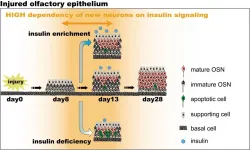(Press-News.org) BOSTON - Peripheral artery disease (PAD), or blockages in the arteries outside of the heart, affects more than 200 million people worldwide and 12.5 million people in the United States. Patients with this circulatory disorder may develop severe leg pain or unhealing wounds that require a minimally invasive revascularization procedure to open the blood vessels to improve blood flow.
For nearly a decade, proceduralists and surgeons have depended on devices coated with a drug called paclitaxel -- which reduces the need for another procedure by up to 50 percent -- during procedures to open the arteries of the leg. However, in the wake of a 2018 study that found a potential link between these drug-coated peripheral devices and death after two years post procedure, the FDA restricted the use of these devices for the treatment of PAD out of an abundance of caution.
At the behest of the FDA, cardiologists Eric Secemsky, MD, and Robert Yeh, MD, both of the Richard A. and Susan F. Smith Center for Outcomes Research in Cardiology at Beth Israel Deaconess Medical Center (BIDMC), designed the Safety Assessment of Femoropopliteal Endovascular Treatment With Paclitaxel-coated Devices (SAFE-PAD) study to provide the information necessary to make scientifically-sound regulatory decisions about the safety of these devices. Using claims data from the Centers for Medicare & Medicaid Services (CMS), the researchers evaluated survival following treatment with these drug-coated devices in more than 160,000 leg artery revascularization procedures conducted between 2015 and 2018.
The team found no statistically significant difference in mortality between patients treated with drug-coated devices and non-drug-coated devices. The report was presented as a late-breaking study at the American College of Cardiology's Scientific Sessions May 16 and published simultaneously in JAMA Internal Medicine.
"Our study of Medicare beneficiaries includes more than 160,000 patients, including more than 30,000 patients with survival data extending past four years, making it one of the largest and most comprehensive evaluations of the safety of drug-coated devices to be published since the initial analysis," said Secemsky, Director of Vascular Intervention at BIDMC and Assistant Professor of Medicine at Harvard Medical School. "Although the 2018 findings raised concerns about the safety of these drug-coated devices, there were many issues with that analysis -- including the study's small size and a lack of complete patient follow-up."
Secemsky and colleagues' study included Medicare patients treated with either a drug-coated or non-drug coated peripheral device between 2015-2018 at nearly 3000 hospitals across the United States. Deaths were evaluated through May 2020, and after accounting for any differences in demographics and co-morbidities between the two groups, the investigators found no evidence that drug-coated devices were associated with higher mortality rates through an average 2.7 years of follow-up, with some patients having follow-up through 5 years.
"We used a number of novel statistical methods to assure these results were accurate, and found consistent results across a number of different patient groups -- including among those of lower overall risk, those with more severe disease, and those treated in outpatient centers," Secemsky said. "We've provided these results to the FDA to make decisions on whether to continue to restrict these drug-coated devices to only those at high risk of needing another leg procedure, or to return to the previous indications where these were used without restriction."
The current publication is the first report of seven planned biannual reports as part of the SAFE-PAD study, which was designed to continue until all patients in the study had follow-up exceeding 5 years. As such, Secemsky and colleagues will continue to analyze these Medicare beneficiaries and update their findings until this study completes in late 2023.
INFORMATION:
Co-authors included Changyu Shen, PhD, and Marc Schermerhorn, MD, of BIDMC.
Funding for the study was provided by a multi-industry consortium, including BD, Boston Scientific, Cook Medical, Medtronic, and Philips. Secemsky receives funding the National Heart, Lung, and Blood Institute (grant K23HL150290) and Harvard Medical School's Shore Faculty Development Award. Yeh receives funding from the National Heart, Lung, and Blood Institute (grant R01HL136708) and the Richard A. and Susan F. Smith Center for Outcomes Research in Cardiology.
Secemsky reported receiving grants from Philips, Medtronic, Boston Scientific, Cook Medical, and BD during the conduct of the study; and receiving grants from AstraZeneca, CSI, and Laminate Medical and personal fees from Philips, Medtronic, Boston Scientific, Cook Medical, BD, CSI, Janssen, VentureMed, Abbott, Bayer, and Inari Medical outside the submitted work. Schermerhorn reported receiving personal fees from Abbott, Cook Medical, Endologix, Medtronic, Philips, and Silk Road Medical outside the submitted work and participating in a scientific advisory board meeting without pay for Medtronic and Philips. Yeh reported receiving grants from BD Bard, Boston Scientific, Cook Medical, Medtronic, and Philips during the conduct of the study; and receiving personal fees from Boston Scientific, Medtronic, Shockwave Medical, and Zoll Medical outside the submitted work. No other disclosures were reported.
About Beth Israel Deaconess Medical Center
Beth Israel Deaconess Medical Center is a patient care, teaching and research affiliate of Harvard Medical School and consistently ranks as a national leader among independent hospitals in National Institutes of Health funding. BIDMC is the official hospital of the Boston Red Sox. For more information, visit http://www.bidmc.org.
Beth Israel Deaconess Medical Center is a part of Beth Israel Lahey Health, a new health care system that brings together academic medical centers and teaching hospitals, community and specialty hospitals, more than 4,000 physicians and 35,000 employees in a shared mission to expand access to great care and advance the science and practice of medicine through groundbreaking research and education.
COLUMBUS, Ohio - Up to 38.6% of people with colon cancer who have a hereditary cancer syndrome--including 6.3% of those with Lynch syndrome--could have their conditions remain undetected with current universal tumor-screening methods, and at least 7.1% of people with colorectal cancer have an identifiable inherited genetic mutation, according to new data published by scientists at The Ohio State University Comprehensive Cancer Center - Arthur G. James Cancer Hospital and Richard J. Solove Research Institute (OSUCCC - James).
Experts say their data, which was gathered from a cohort of more than 3,300 colorectal cancer patients treated at 51 hospitals across Ohio, makes a strong scientific argument for implementing multi-gene panel ...
A team of Welsh academics has developed a new method of supporting health professionals to make clinical decisions about people who may be at risk of taking their own lives.
While the UK may have one of the lowest rates of suicide in the world, it is still the biggest cause of death in men under 45, so being able to make a Structured Professional Judgement about who might attempt suicide and knowing how to intervene is vitally important.
Researchers at Swansea and Cardiff universities have put together the Risk of Suicide Protocol (RoSP) which guides a professional to look at 20 aspects of a person's life known ...
PHILADELPHIA (May 17, 2021) - Researchers have known for some time that insulin plays a vital role in regeneration and growth in some types of neurons that relay environmental sensory information to our brains, such as sight. However, they know relatively little about the role of insulin in the sense of smell. Now, investigators at the Monell Chemical Senses Center have shown that insulin plays a critical role in the maturation, after injury, of immature olfactory sensory neurons (OSNs). The team published their findings in eNeuro earlier this month.
"Our findings suggest ...
One of the projected effects of a warming climate for species living on mountain slopes is moving their distributions upslope as their habits shift upwards. Eventually, since mountains have a limit to their elevation, a species may have no more habitat to move up to and therefore go extinct. Tracking how and where this is happening is tough, though, if you don't have a good idea of where the species are now. That's the situation in places such as Africa, which have tremendous biodiversity but spotty ecological baseline data.
So University of Utah researchers set out to assess the status of bird species in Ethiopia's Bale Mountains through six years' worth of bird banding efforts at five sites. The sites spanned ...
Mothers who are Hispanic or who come from rural or low socioeconomic status neighborhoods are less likely to have their child's critical heart condition diagnosed before birth, according to a new study in the journal Circulation.
This is the largest and most geographically diverse study of these challenges to date. The study compared patient data of more than 1,800 children from the United State and Canada diagnosed with two of the most common, and the most serious, critical congenital heart defects: hypoplastic left heart syndrome (HLHS), when the left side of the heart is not developed completely, and transposition of ...
Patients with chronic kidney disease and Type 2 diabetes who took the experimental drug finerenone were about 30% less likely to develop the heart rhythm disorder atrial fibrillation (AFib) than those taking a placebo, according to data presented at the American College of Cardiology's 70th Annual Scientific Session.
Last year, researchers reported that the trial, called FIDELIO-DKD, met its primary endpoint showing a significant benefit of finerenone, a nonsteroidal, selective mineralocorticoid receptor antagonist, in terms of a composite of sustained decrease in kidney function, kidney failure and renal death. The new analysis reveals that patients derived these benefits regardless of their history with AFib and suggests that taking finerenone also reduced the rate of ...
A subgroup of patients who experienced an out-of-hospital cardiac arrest (OHCA) that did not respond to standard advanced cardiac life support (ACLS), were immediately transported to a cardiac care center, and placed on a device similar to a heart-lung bypass machine were more likely to have survived with good brain function six months later than similar patients who received standard care at the site where the OHCA occurred. The study was presented at the American College of Cardiology's 70th Annual Scientific Session.
"This study--the largest randomized clinical trial that has been conducted to address this question--shows that a hyperinvasive ...
The ocean is a big place with many deep, dark mysteries. Humans have mapped no more than 20% of the sea, and explored less. Even the kelp forests of Southern California -- among the best studied patches of ocean on the planet -- hide species not yet described by science.
Now, UC Santa Barbara's Thomas Turner has published a paper in the journal Zootaxa describing four new species of sponges. These novel specimens weren't dredged from the murky depths or found on some distant seamount, but collected locally from popular dive spots. The study brings Turner's new species count to five, and the scientist believes there may be dozens yet to discover and describe along the West ...
Southern lesser galagos (Galago moholi), a species of primate that lives in southern Africa, boast big, round eyes and are so small they can fit in your hand.
A new study from an international team of scientists, however, suggests that there may be a downside to their cuteness: The trade in lesser galagos, also known as bushbabies, which some people keep as pets, may have shifted the genetics within their wild populations over the span of decades, according to the research. Those changes could undercut the ability of the critters to adapt as human farms and cities grow throughout the region.
The study was published recently in the journal Primates and ...
Alcohol appears to have an immediate--or near-immediate--effect on heart rhythm, significantly increasing the chance that an episode of atrial fibrillation (AFib) will occur, according to new data presented at the American College of Cardiology's 70th Annual Scientific Session.
The data revealed that just one glass of wine, beer or other alcoholic beverage was associated with twofold greater odds of an episode of AFib occurring within the next four hours. Among people having two or more drinks in one sitting, there was a more than threefold higher chance of experiencing AFib. Using an alcohol sensor placed on participants' ankles, which passively monitored alcohol intake, the investigators ...


